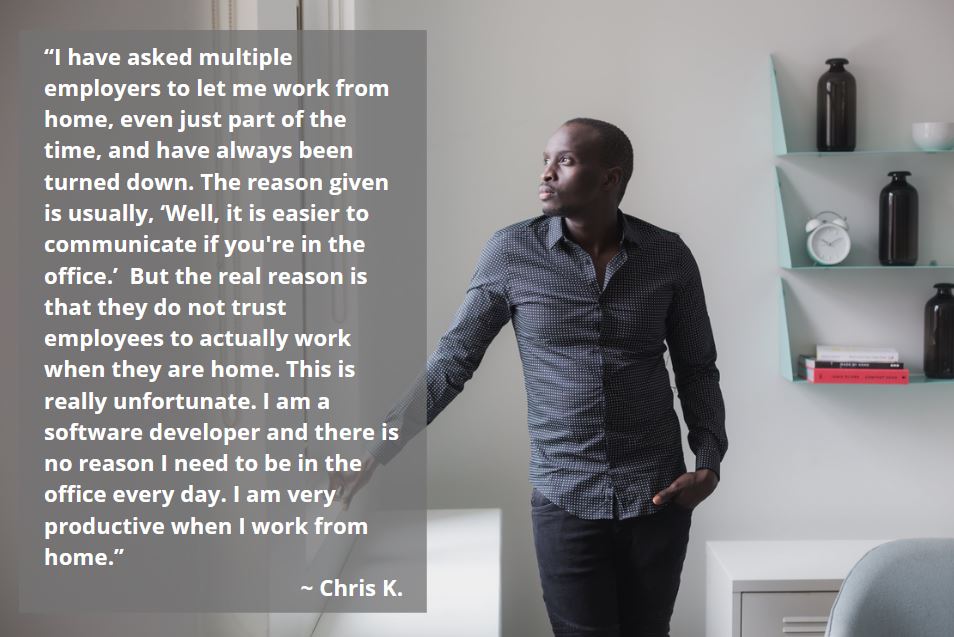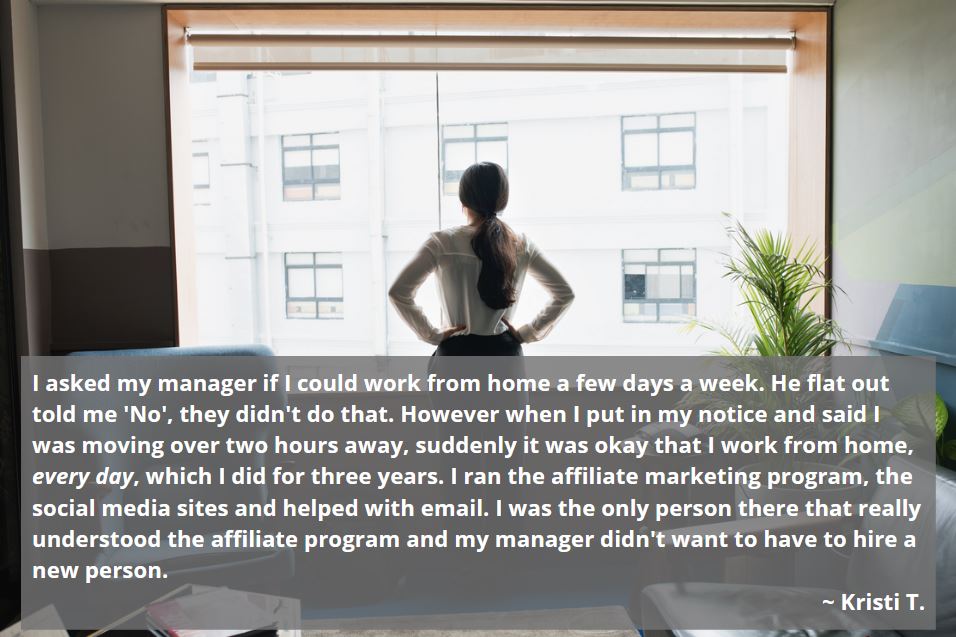Why Your Boss Says “No” to Working from Home

Why do bosses say no to working from home? What are the reasons they can’t seem to see the value of remote work?
Remote work is more popular than ever, but getting employers on board still isn’t easy. Here are the top reasons some managers are resistant to letting employees work from home.
-
Managers are afraid of being seen as unfair.
-
Managers think working from home makes collaboration difficult.
-
Managers believe communication will be too challenging.
-
Managers don’t want to go against established company policies.
-
Managers are concerned about data security.
-
Managers think working from home brings too many distractions.
“If I let you work from home, I’ll have to let everyone.”
Although managers would like to believe they do things fairly across the board, they don’t. Nor should they. Employees don’t get the same pay, they don’t all get the same raises, and there is no company-wide promoting of employees.
Ideally, employees get what they earn, be it paychecks, raises, or the freedom to work from home. That means if over time an employee has proven to be capable, their employer would give them more freedom. Especially if evidence shows that working from home will benefit the company’s bottom line.

Employers are afraid of being unfair if they let some, but not all, employees work from home.
Managers who are in tune to the different levels of staff performance know who is capable of working from home, and those who need closer supervision. Despite this, requests to work from home have been, until the pandemic, overwhelmingly denied. Even as offices began opening up to onsite workers, after a year of everyone working from home, micromanagers are once again reluctant to give staff the choice to work from home. The excuses given to deny remote work are so routine, we can almost predict them.
“It’s easier to collaborate when we’re all together.”
From Yahoo! to Aetna, industry giants like these have made headlines by lassoing their home based workers back into the office, all in the name of improving employee collaboration and creativity.
The fact is, “collaborating” is just easier for managers when everyone is in one place. As far back as the 1960s Dame “Steve” Shirley noted that collaboration is more about how management operates, than staff proximity or even the tools used for collaboration.
Frequent meetings are viewed by many managers as effective ways to get everyone on the same page. In actuality, constant meetings are nightmares for most employees, as very little collaboration occurs in these meetings.
According to a study by Wrike Management, “more than a quarter of employees attend six or more meetings a week. However, only 46% say they leave a meeting with a clear understanding of what to do next.” Instead, Wrike writes, such meetings become platforms for the loudest employees to push their own ideas, leaving everyone else unheard.
“It’s easier to communicate when everyone’s at the office.”
It’s certainly easier to strike up a conversation when someone sits at a desk next to yours. And, “chance encounters” at a water cooler encourage chit chat, too. But how useful are these conversations? How productive is all this chatting? The reality is that much in-office communication is more small talk and unnecessary interruption than useful communication.
As for managers who claim to have an open door policy, how often is that used to spur spontaneous communication or sharing of ideas with their staff?

The real reasons many managers discourage working from home boils down to lack of trust and convenience.
According to an HBR.org, article, What Great Managers Do To Engage Employees, “mere transactions between managers and employees are not enough to maximize engagement. Employees value communication from their manager not just about their roles and responsibilities but also about what happens in their lives outside of work. The Gallup study reveals that employees who feel as though their manager is invested in them as people are more likely to be engaged.”
Improved quality of interactions between managers and employees can happen whether an employee is working onsite or is working from home. Successful communication is more about how well people communicate with each other, rather than where they are while they’re communicating. “Furthermore, telecommuting permits greater forethought in other types of communications, which may prevent conflicts so typical in many workplaces.” (Myths & Facts About Remote Employees, TeleworkRecruiting.com)
“Working from home is against company policy.”
Policies become policies only because someone made them into policies. Unlike The 10 Commandments, policies are not engraved in stone. In fact, a company that isn’t flexible enough to modify a policy based on current or changing situations is asking for trouble.
Many managers are highly resistant to change, which is why they rely on policies. They use policies as crutches to avoid new ways of thinking and resist change, even if for the better. Change Management is difficult and resistance to change is deeply embedded in far too many organizations. Yet, for any business to move forward, change must happen when it is time. Never has this been more evident than during the recent pandemic.

Sadly, a threat or disruption is what’s needed to get employers to let staff work from home.
Any time management does not periodically reevaluate its policies it’s difficult to generate progress, as employees or as a company. Any empirical data supporting the benefits of working from home will fall on deaf ears because managers keep falling back to, “It’s not our policy.” Only when a situation, such as COVID-19, threatens the department or organization does management become willing to reevaluate policies and institute changes. Sometimes, however, change comes too late.
“Remote work puts company data at risk.”
It’s true that employee error or negligence accounts for almost 70% of the causes of security breaches. Data breaches happen all too often. Yet, a review of these breaches reveal that none of them—certainly not the most damaging ones—resulted directly because someone worked from home.
It’s not remote work per se that creates security risks; it’s a lack of necessary safeguards—all which a company can provide to a remote employee. “If a company provides the same protection to teleworkers as they do onsite workers then there is no reason to assume that teleworking will create data security risks,” reads one article on employer reasons for denying remote work.
Security breaches can happen from any location, and that’s because security is not a location issue as much as it is a people issue. A bad (or careless) employee will do bad things regardless of where they work. Likewise, a good employee (and home based employees tend to be better employees), will be good whether onsite or at home.
“There are too many distractions at home for you to get work done.”
Many managers voice concern that working from home will be too distracting for remote employees to accomplish anything. They say distractions at home will impede on staff productivity and therefore affect the organization’s bottom line.

Many managers fear they can’t micromanage employees if they’re working from home. They are uncomfortable with that lack of control.
It’s true that working from home might mean being interrupted by the occasional deliveryman or pile of laundry. Yet, study after study has shown that working from home increases employee productivity. In fact, “escaping the distractions in the office can help employees become more efficient,” writes Jabra.com in an article on remote work and productivity.
In-office distractions are more frequent and are the biggest cause of reduced productivity. Why? Because even a 15-second distraction (such as a colleague pausing at your desk to see if you’re going to lunch) can take an employee up to twenty minutes or more to refocus on their task. Studies have also shown that increased distractions, especially unnecessary distractions like coworker chit-chat, increase work errors , giving the interrupted worker “an experience of workload increase”, even though no real change occurred.
A final word
Any time you request something out of the norm for your company, such as working from home, timing is everything. There are better times than others to stage your request.
Good time:
- After you’ve accomplished something outstanding
- After you’ve done something valuable for the team
- When you’ve reached a new level of communication with your manager
- When a situation demands it, such as a pandemic
Bad time:
- When your boss is waiting to hear about a promotion
- When your department has suffered a setback
- When conflict is happening on your team
Your turn: What employer concerns have you heard in the past when wanting to work from home?
Let’s talk more about it. Join us on Facebook and LinkedIn
Does your resume need help? Check out our resume rewrite packages!
[Article updated from 2019]
Category: Featured, Telecommuting, Work-Life Balance










Great article really has been very useful to me. Thank you!!! Thank you so much!!!